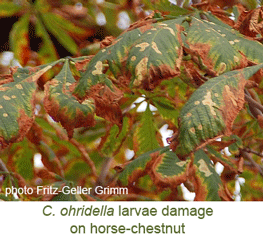Tracing invaders with DNA
 The horse-chestnut leaf miner moth Cameraria ohridella (link to Encyclopedia of Life species page), first described as an apparent endemic in Macedonia in 1984, has steadily expanded its range over the past 25 years, turning once attractive stands of horse-chestnut trees in many urban areas across Europe into unsightly arrays. The damage results from larvae feeding on the leaf interior (ie “leaf mining), causing extensive mottling and leaf loss. C. ohridella is an “invasive pest” in Europe and the subject of an international symposium in Prague in 2004 aimed at identifying biocontrol methods. For such a well-known and important organism, one might expect that scientific information would be readily available. As above, there is an excellent EOL species page, but I was unable to find the original species description online (Deschka G, Dimic N. 1986. Acta Entomologica Jugoslavica, 22, 11-23). A number of museums and universities have print copies of this journal, and I could request a photocopy through Rockefeller University inter-library loan, although of course that service is not available to the public. I did find a complete set of AEJ available from antique bookseller (the journal ceased publication in 1990) for about $500 US! For wider access, I hope that EOL pages will include links to original species descriptions when available as out-of-copyright or open-access.
The horse-chestnut leaf miner moth Cameraria ohridella (link to Encyclopedia of Life species page), first described as an apparent endemic in Macedonia in 1984, has steadily expanded its range over the past 25 years, turning once attractive stands of horse-chestnut trees in many urban areas across Europe into unsightly arrays. The damage results from larvae feeding on the leaf interior (ie “leaf mining), causing extensive mottling and leaf loss. C. ohridella is an “invasive pest” in Europe and the subject of an international symposium in Prague in 2004 aimed at identifying biocontrol methods. For such a well-known and important organism, one might expect that scientific information would be readily available. As above, there is an excellent EOL species page, but I was unable to find the original species description online (Deschka G, Dimic N. 1986. Acta Entomologica Jugoslavica, 22, 11-23). A number of museums and universities have print copies of this journal, and I could request a photocopy through Rockefeller University inter-library loan, although of course that service is not available to the public. I did find a complete set of AEJ available from antique bookseller (the journal ceased publication in 1990) for about $500 US! For wider access, I hope that EOL pages will include links to original species descriptions when available as out-of-copyright or open-access.
This leads to report in July 2009 Mol Ecol by researchers from France, Switzerland, Hungary, and Canada, using mitochondrial and microsatellite DNA markers to trace origin of C. ohridella. For this remarkably wide-ranging study, the researchers analyzed 486 specimens from 88 localities in 22 European countries, collecting a single individual per leaf per tree, and if possible, from 30 different trees at each collecting site. To skip to the conclusion, consistent with historical pattern of spread north and west through Europe, the invasive form of the moth appears to be derived from populations infecting wild horse-chestnut trees in the southern Balkans. The genetic diversity was greatest in natural forests in Macedonia, Greece, and Albania, whereas the individuals collected from all “artificial” habitats (ie planted trees in parks, gardens, and roadsides across Europe) had nearly identical COI barcode sequences, consistent with recent expansion from a single source. The important practical conclusion is that biocontrol agents in the form of natural parasitoids are most likely to be found in wild stands of horse-chestnut in southern Balkans. I look forward to more studies on detecting and monitoring invasive species with DNA.
This entry was posted on Monday, August 31st, 2009 at 10:43 pm and is filed under General. You can follow any responses to this entry through the RSS 2.0 feed. Both comments and pings are currently closed.
September 1st, 2009 at 8:45 am
[…] and microsatellite polymer markers to analyse lineage of C. ohridella. See more here: The Barcode of Life journal » Blog Archive » Tracing invaders with DNA Posted in Uncategorized | Tags: and-microsatellite, dna, france, hungary, Leads, remarkably, […]
September 2nd, 2009 at 8:09 am
In response to your point above have now placed a link to a scan of the species description at http://eolspecies.lifedesks.org/pages/8675
which should later be updated on the main web page
September 4th, 2009 at 9:44 am
Dear Mark,
Another interesting post – would also like to add that, like fish fillets, many commercially available biocontrol agents sold under a single trade name have divergent barcodes, suggesting they are not all the same species. Because biocontrol agents sometimes impact non-target species and become invasive themselves, we’ve been advocating for a barcode-based registry of biocontrol agent release…
September 11th, 2009 at 11:05 pm
David,
Nice work, thanks for update!
Mark
September 11th, 2009 at 11:08 pm
Bob,
Good point. To start would be interesting to know if their is a compilation or registry of species introduced as biocontrol agents.
Mark